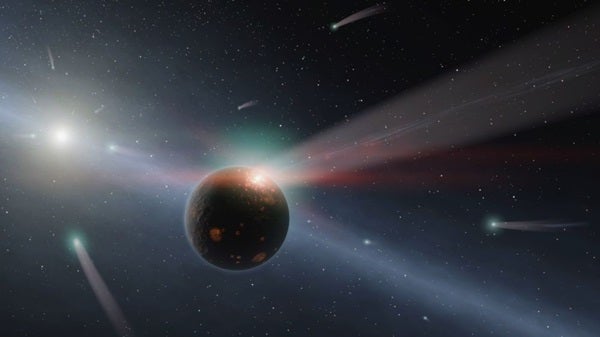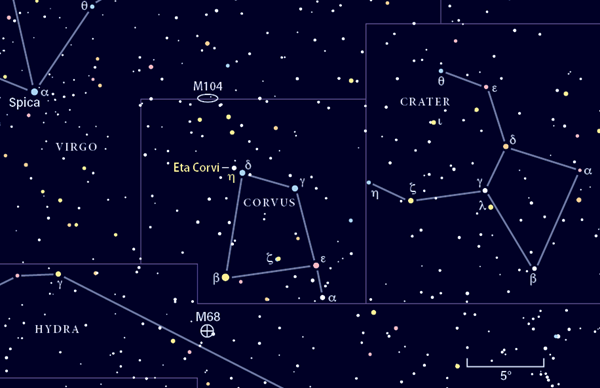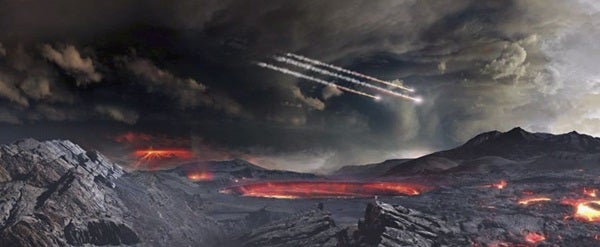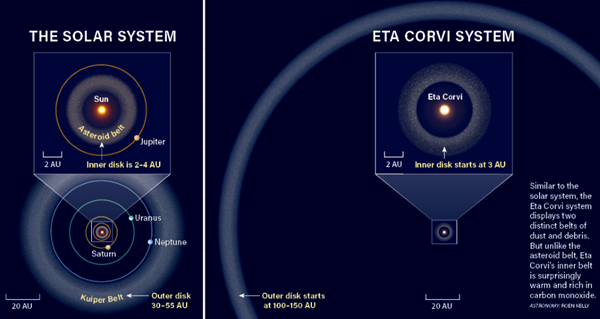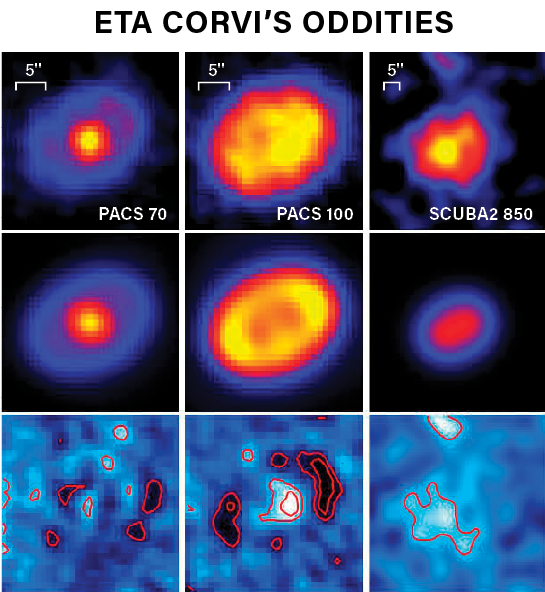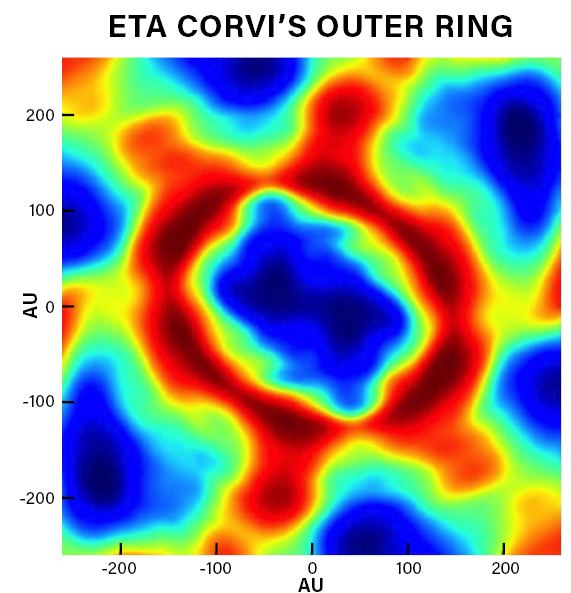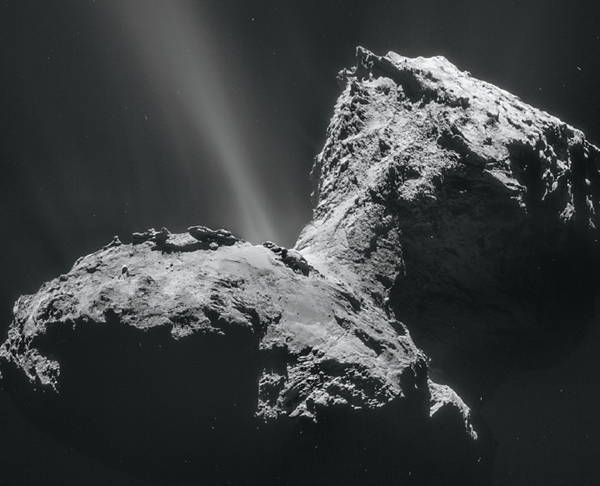Our solar system’s comets are believed to have delivered a wealth of material to early Earth. Among the icy visitors’ suspected gifts were rare gases, small amounts of water, and organic material — all of which could have helped terrestrial life form and evolve. But while ancient Earth received only a moderate influx of comets, any planets around young nearby star Eta Corvi are likely raking in cometary currency.
After planets form in a fledgling system, the host star is surrounded by a disk of leftover gas and dust that didn’t get molded into new worlds. In our solar system, this surplus of material settled into two bands: the asteroid belt between Mars and Jupiter and the Kuiper Belt beyond Neptune. While members of the asteroid belt are rocky and relatively dry, comets in the Kuiper Belt tend to be ice-rich and filled with gases. But both types of objects can help seed planets with the ingredients necessary for the evolution of life as we know it.
And then there’s Eta Corvi — a 1.5-billion-year-old star that sits just 60 light-years away. Decades ago, researchers used the Infrared Astronomical Satellite (or IRAS) to find evidence that Eta Corvi sports a massive outer ring much larger and more distant than the solar system’s Kuiper Belt. But when Mark Wyatt, then an astronomer with The Royal Observatory, Edinburgh, turned the James Clerk Maxwell Telescope in Hawaii toward the star in 2005, he found a surprise: The Eta Corvi system also boasts a ring of hot material much closer to the star itself. “There is something unusual going on in the inner region of this system,” Wyatt, now at the University of Cambridge, says.
At first, astronomers thought that Eta Corvi could just be going through a period much like the solar system’s suspected Late Heavy Bombardment (LHB), which saw the inner planets pummeled by asteroids some 4 billion years ago. During this time, Neptune and Uranus performed an intricate dance that banished them to the outskirts of the solar system. And as the ice giants migrated, they kicked up material from the Kuiper Belt and hurled it back toward Earth and the other rocky planets. Although the timing remains uncertain, some astronomers think the material delivered during this cosmic barrage played a vital role in helping our planet become habitable.
Smashing comets, smashing planets
Comets are common, both within the solar system and beyond. And although they are incredibly challenging to spot around other stars, these icy chunks are expected to be widespread. Thanks to improved technology and methods, astronomers have identified more than 25 systems that are thought to host exocomets, as well as minor bodies like dwarf planets.
Most of the exocomets seen today are around A-type stars, which shine hotter than our G-type Sun. Because A-type stars rotate quickly, astronomers can more easily spot the light-blocking cometary material that’s around them. The faster rotation means it’s easier to determine whether a star’s brightness is changing due to passing dust, says Isabel Rebollido, a Ph.D. student at Spain’s Universidad Autónoma de Madrid.
In addition to its massive exo-Kuiper Belt, Eta Corvi also has an interior belt of warm material within about 3 AU of its star. The inner band is rich in carbon monoxide, which gets destroyed by stellar radiation in just over a century. “The fact that we’re seeing this carbon monoxide now, it either means that we’re very lucky to be observing it, [or] it’s a continuous process,” says Sebastian Marino, an exoplanet researcher at the Max Planck Institute for Astronomy in Germany. The composition of the interior disk also suggests it originally formed farther from the star before later migrating inward.
Another possibility is that Eta Corvi is still suffering a violent childhood, with excess material smashing together well after any planets should have cleared out their orbits. “While smashing,” Marino says, “they release some of the gases and ices that are inside.” However, that stands at odds with astronomers’ idea for an aging toddler system like Eta Corvi.
“We expected that the younger the system, the higher the dynamical interactions because it’s still settling,” Rebollido says. After a billion and a half years, Eta Corvi should have calmed, most of its debris swept up by successful planets. “It doesn’t quite agree with our idea of how planetary systems form and when they settle down,” Rebollido says.
Bucket brigade
When Neptune and Uranus underwent what scientists call dynamical instability, trading places while moving outward through the solar system, they cleared debris from the inner edge of a once-wider Kuiper Belt. To get an idea of how Eta Corvi’s belts formed, Marino and his colleagues decided to model possible configurations of worlds and how they might pass material inward, as well as carve out the observed exo-Kuiper Belt. Marino wanted to figure out what kind of planets it would take to feed comets from the system’s outermost edges to its innermost regions.
First, he and his colleagues looked at whether Eta Corvi could be undergoing its own version of LHB. When Neptune and Uranus migrated, they not only hurled cometary material inward, they also foundationally changed the structure of the Kuiper Belt. Previous studies suggest that, during the solar system’s LHB, the Kuiper Belt would have been broad, and features such as spiral arms could have formed within it.
Using the Atacama Large Millimeter/submillimeter Array (ALMA), Marino’s team probed Eta Corvi’s outer disk for signs of a giant planet stirring things up. Their observations showed no hints of spiral arms or other structures. “It seems unlikely that a dynamical instability in the system similar to the LHB is responsible,” the authors concluded in their paper.
When Neptune and Uranus plowed into the Kuiper Belt, they sent roughly 30 Earth masses’ worth of cometary debris to the inner solar system over a period of 15 million years. But not all of the comets made it. Jupiter, the largest of the planets, stands as sentinel for the terrestrial planets. While the gas giant lets some of the Kuiper Belt material fly by, most of it winds up getting diverted elsewhere, sometimes being ejected from the solar system entirely. “Only one in a million comets that got scattered inwards made it to collide with Earth,” Wyatt says.
If Eta Corvi has its own chain of worlds, the planetary conga line could allow material to leapfrog inward. But the existence of a giant inner dust cloud suggests that there is no Jupiter-like world guarding any rocky planets near Eta Corvi. According to Wyatt, the rate at which comets are hurled toward Eta Corvi is roughly 100 times less than the solar system experienced in its prime. However, without a Jupiter-like sentinel, more of that material actually succeeds in making it to the inner part of the Eta Corvi system.
Using simulations, Marino and his colleagues found that a chain of fewer than 10 worlds of roughly the same size — each weighing between 3 and 30 Earth masses — could easily hand off cometary material from one to the next. This is one possible way in which the system could continue to maintain its inner, warm disk of material that we see today.
When Wyatt and his colleagues reexamined the system, they found Eta Corvi’s inner dust cloud was not spread evenly around the star. Instead, a massive clump of material appeared close to the star. Once again, the clump could have been produced by either comet-comet or comet-planet collisions.
Marino’s team investigated how likely it might be for the icy material cast inward to collide with other comets or a planet. In order for the inner disk to have formed from mutual cometary collisions, though, the range in size of the cometary dust grains would have to be dramatically different from what’s expected, and the grains themselves would have to shine significantly brighter than they do. On the other hand, the excess warm dust could form if a comet collided with a rocky world between four and 10 times as massive as Earth, making this the more likely scenario.
While most of Earth’s water came from asteroids, comets provided some of the ingredients necessary for life to evolve. Because of that, Eta Corvi “can have some quite important implications for what’s going on on a planet in terms of the potential for the development of life,” Wyatt says.
Some researchers have suggested Earth got part of its atmosphere from comets, while others think that impacts could have aided in the development of life. So by studying Eta Corvi, astronomers may get a better understanding of what happened early in the life of the solar system. “Whenever we look at a system younger than our solar system, we’re kind of looking in the past,” Rebollido says.
Of course, the best way to understand how Eta Corvi’s hypothetical worlds evolve is to actually observe them. “It would be great if we could detect the planets,” Wyatt says. But that won’t happen in the near future.
Eta Corvi’s outer planets are likely Neptune-sized worlds. Direct imaging, which is akin to photographing a planet, is the best method for spotting worlds that lie so far out, but exo-Neptunes are too small to be spotted with current or even upcoming instruments. Directly imaging an exoplanet often relies on capturing the residual heat seeping from a recently formed world, and Eta Corvi’s planets are likely too old to have enough heat left from their birth to be seen from afar.

Want to learn more about pulsars and other extreme objects in our universe? Check out our free downloadable eBook: Exotic objects: Black holes pulsars, and more.
Either way, Wyatt and his colleagues want to re-observe the system. If the clump they spotted in the inner disk is orbiting the star, they should see it move with time. The researchers also hope to confirm the system’s cometary fingerprints with further observations. “We should be able to map the carbon monoxide distribution,” Wyatt says. “That will tell us more about what’s going on.”
At the same time, the recent arrival of an exocomet in our own solar system could help decode the mysteries of Eta Corvi. At the time of this writing, Comet 2I/Borisov, discovered in August 2019, is currently breaking up. By studying its spilled guts, astronomers hope to probe the object’s composition to learn how comets in other star systems compare to our own.
“This kind of comet visiting us could have formed in a system like Eta Corvi,” Marino says. But instead of colliding with another comet or planet, Borisov was ejected. This, he adds, “will tell us about comets that are farther out.”
Rebollido is also excited to see the interstellar interloper pass through our solar system. “It’s the proof that cometlike bodies are being formed [in other systems],” she says. “I’m curious about the composition — and, specifically, whether it’s similar to our solar system comets or not.”
Researchers might also better understand our solar system’s own past by continuing to study the Eta Corvi system. But with its unique pair of disks, Eta Corvi clearly has something special going on.
Regardless, this single young system rich in cometary material may reveal a lot about how our solar system and others formed and evolved over time. According to Marino, “Eta Corvi is kind of the tip of the iceberg.”

